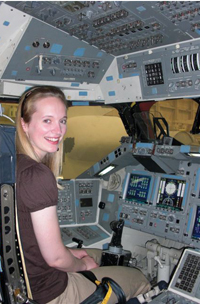Sources: Heather Arnold, harnold@k-state.edu;
and Andrew Rys, 785-532-4665, andrys@k-state.edu
Photo available. Contact media@k-state.edu or 785-532-6415.
Video available. Access at http://www.k-state.edu/media/webzine/research/index.html
News release prepared by: Kristin Hodges, 785-532-6415, khodges2@k-state.edu
Tuesday, April 21, 2009
K-STATE SENIOR FROM TOPEKA RESEARCHES MORE EFFICIENT LIGHTING SOURCES
MANHATTAN -- Producing electricity for lighting costs U.S. consumers billions every year, and the costs are expected to increase. However, a Kansas State University engineering student is researching more efficient lighting sources.
 K-State's Heather Arnold, senior in electrical engineering, Topeka, said the average incandescent light bulb is about 5 percent efficient, and a fluorescent lamp is about 20 percent efficient.
K-State's Heather Arnold, senior in electrical engineering, Topeka, said the average incandescent light bulb is about 5 percent efficient, and a fluorescent lamp is about 20 percent efficient.
"Of the many alternatives to incandescent bulbs and fluorescent lamps, solid-state lighting, in the form of white light-emitting diodes, or LEDs, is a promising solution to the problem," she said.
White LEDs are currently available on the market, though they are not very efficient and emit a cool white light that is not ideal for home lighting, Arnold said. A better white LED for home lighting would be composed of red, yellow, green and blue LEDS. However, green LEDs are inefficient and too dim to be used for lighting in homes and offices.
Arnold has been working under K-State's James Edgar, professor of chemical engineering, and Andrew Rys, professor of electrical and computer engineering, to develop a higher-intensity green LED so that intense and efficient white LEDs can be possible. To achieve higher-intensity green LEDs, the researchers are learning how to grow higher-quality samples of wide band-gap semiconductors.
Arnold's role in the project is electrically characterizing the semiconductors. Her characterization helps optimize the growth process of the films.
"I enjoy working on a project that could directly impact society," Arnold said. "Energy costs and consumption are a major concern worldwide, and I get fulfillment in attempting to solve such a large-scale problem."
Rys said Arnold's research has been funded through a K-State Targeted Excellence grant for the project "Center for Sensors and Sensor Systems."
"Heather is a very enthusiastic person who is motivated and a quick learner," Rys said. "I really enjoyed working with her. I think she will have a successful career in engineering and materials science.
Arnold also has served numerous co-op tours at the Johnson Space Center and currently is a cooperative education student there. She will return to K-State for the fall 2009 semester and will continue her research with Edgar and Rys.
"I attribute my interest in engineering to a visit to Marshall Space Flight Center on a family vacation when I was 9 years old," Arnold said. "I was fascinated by human space flight and asked my father how he thought I could someday work for NASA. He told me I would have to become an engineer. I never gave up that dream of working for NASA, and luckily it came true in fall 2007 when I was selected as a Johnson Space Center cooperative education student."
Arnold also has been a technology services intern at the Burlington Northern Santa Fe Railway in Topeka.
She plans to earn a doctorate in materials science and engineering and pursue a research career in aerospace materials. From her experience working at the Johnson Space Center, she said she would like to continue a career researching materials for NASA programs.
"It's pretty hard to top what I'm doing right now -- the opportunities for exciting work at NASA are endless," Arnold said.
Arnold is the secretary of K-State's Institute of Electrical and Electronics Engineers and a former webmaster of K-State's Circle K Club. She is a member of K-State's engineering honor society Tau Beta Pi, the electrical engineering and computer engineering honor society Eta Kappa Nu and Phi Kappa Phi national honor society.
She has received the Henry and Florence Ruff Scholarship; the AT&T scholarship for Employees Children; the Northrop Grumman Scholarship for Employees Children; the Johnson Space Center Coop Special Achievement Award twice; the Girl Scout Gold Award; the Henry and Helen Greene scholarship; the Kansas State University Medallion scholarship; the G.E. Johnson Engineering scholarship; the National Association of Retired Federal Employees scholarship; and the Dillon Electrical Engineering scholarship.
A 2004 graduate of Washburn Rural High School, she is the daughter of Tom and Ann Arnold, Topeka.